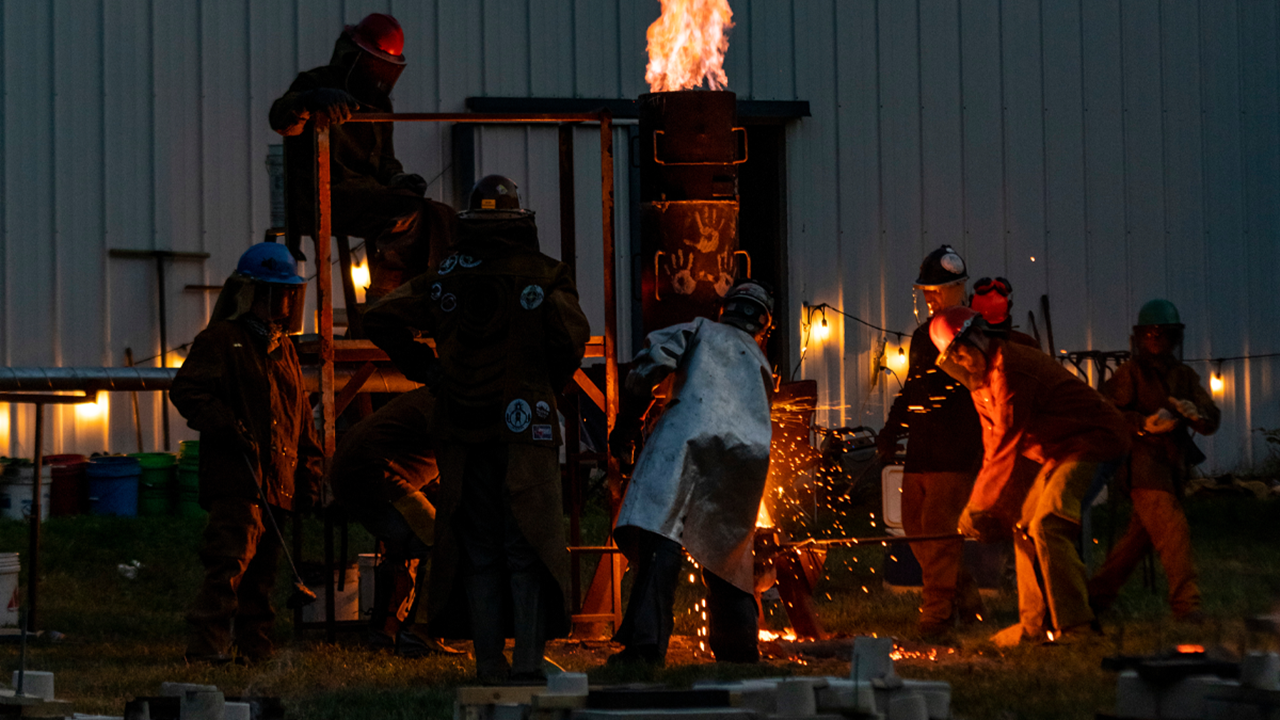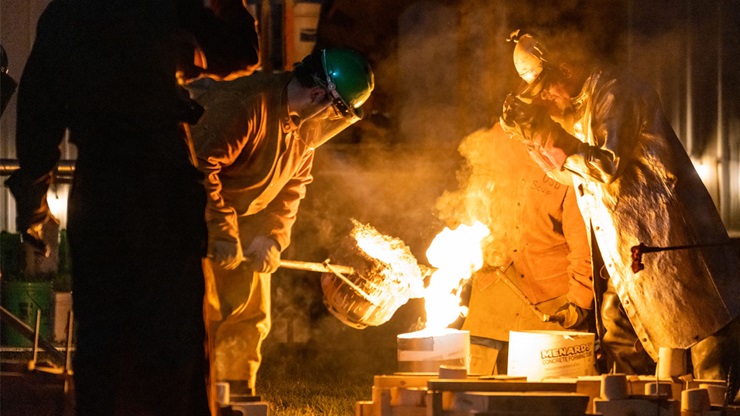A Decade of Pouring: 10th Annual Little Pour on the Prairie Scheduled for June 24

The Little Pour on the Prairie, led by Associate Professor of Art Chris Meyer, is a community-based event where students and artists participate in both production pours and performance pours, producing a unique art experience for both participants and audiences alike.
This year’s Little Pour on the Prairie is scheduled for June 24 at 7 p.m. Open to the public, the pour and performances will take place at 30635 456th Ave. in Volin, South Dakota. Prior to the pour, students will work on molds for the iron pour at the Warren M. Lee Center for Fine Arts on USD’s campus from June 20-23.
10 Years of Pouring
In 2014, Meyer held the inaugural Little Pour on the Prairie event. Essentially a practice run to test new furnace equipment, the first pour brought together current and former students as well as regional cast iron artists and practitioners.
“As it turns out, it was a lot of fun to come together, make art, camp, meet new people and hang out with old friends,” said Meyer.
The Little Pour on the Prairie has since continued to grow. In 2014, the Little Pour on the Prairie was the only iron pour in South Dakota, but now, there is an iron pour on USD’s main campus at least every semester. There are also multiple iron pours at Bronze Age Art Foundry in Sioux Falls, which was started by USD sculpture alumnus Jordan Eaton ‘13.
Prior to the pandemic, the pour was large enough to require two furnaces and had as many as 50 participating artists from 17 states. Over the last three years, the Little Pour on the Prairie has been a smaller event, but Meyer said he hopes that the 10th annual pour “will be a return of more spectators and a celebration of the event.”
To commemorate the 10th annual pour, Meyer is putting together a sculpture exhibition associated with the pour titled, “Of Broken Molds,” which includes work from a group of former students and regional artists who have been associated with the Little Pour on the Prairie since its inception. The exhibition will be on display at the First Dakota Coyote Gallery June 19-Aug. 2, and a reception is scheduled for June 23 at 7 p.m.
The Art of Pouring
“I have come to have a deep appreciation for iron,” said Meyer. “The entire process of casting iron is more visual than other cast metals. From the 2,500-degree molten iron and the sparks it creates, to the coordinated movements of the pour floor crew, there is always something to see at an iron pour."
Leading up to the event, Meyer hosts workshops where students make molds to take to the pour. Then, participants engage in a production pour, where the molten iron is poured into sand or ceramic shell molds.
Generally, iron pours take place outdoors because the process of melting iron requires using a solid, carbon-based fuel to melt the iron. Pourers use coke, a fuel for blacksmithing, and forced air to run the furnace, and fuel must be physically fed to the furnace to keep it going.
In addition to the production pours, students and artists also engage in performance art casting, which involves pouring iron into molds that are not made from refractory materials, but rather reactive materials – such as wood, paper, ice, seed-corn and more. This allows the iron to be purposefully distributed for artistic performance.
“I have always incorporated iron performance into the Little Pour on the Prairie, and it has become one of the continuing themes of the pour,” said Meyer. “I think that people look forward to seeing the exciting spectacle of fire and sparks each year.
A Community of Pouring
Besides creating the molds for the cast iron sculptures, there is a lot of work that goes into an iron pour. All the materials the artists used must be processed by hand, requiring them to break iron and coke charges to size, weigh and bag charges, repair the furnace and tools for the pour, and more. Running an event like this also requires extensive planning, organization and set up.
“The truth is that I couldn’t do this without my students,” said Meyer. “My students, both current and former, help with all of it, as it takes many people working together to have a successful pour.”
From the beginning, Meyer has involved not only current and former students, but also regional artists to participate and assist in the annual Little Pour on the Prairie event.
“One of the things I love about cast iron art, maybe even the thing I love the most, is the community,” said Meyer. “I’ve had the opportunity to meet so many diverse and incredible people. I think of the Little Pour on the Prairie as a reunion of sorts – a chance to get together and share in the creation of each other’s art again.”
With the cast iron art movement still being relatively young in the art world, Meyer said he hopes events like these can continue to grow the cast iron community.
“The very nature of this work creates community through necessity,” said Meyer. “Community and a sense of belonging is essential, now more than ever. I hope that the iron community continues to grow. The Little Pour on the Prairie is part of that.”

